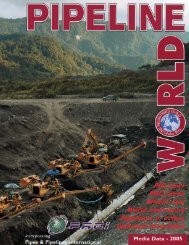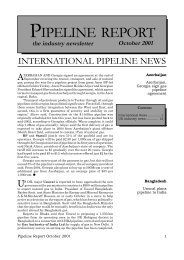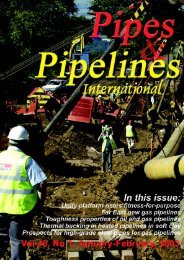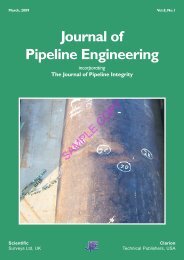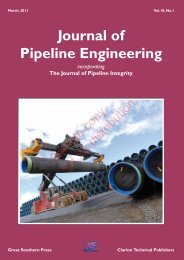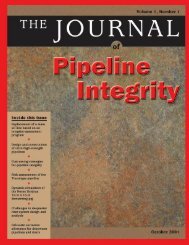JPE - Sept09 - cover2-4.pmd - Pipes & Pipelines International ...
JPE - Sept09 - cover2-4.pmd - Pipes & Pipelines International ...
JPE - Sept09 - cover2-4.pmd - Pipes & Pipelines International ...
Create successful ePaper yourself
Turn your PDF publications into a flip-book with our unique Google optimized e-Paper software.
180<br />
Crack Mouth Opening Displacement (inches)<br />
0.004<br />
0.003<br />
0.002<br />
0.001<br />
δ<br />
0.1 mm<br />
a<br />
σ<br />
t<br />
σ<br />
0.000<br />
0 500 1000 1500 2000 2500<br />
cracks under either the MAOP or an external soil load that<br />
will yield the entire pipe, an analysis must be performed to<br />
evaluate the crack opening for such cracks under such<br />
loads.<br />
To put an upper bound on the crack mouth opening<br />
displacement (CMOD), the crack geometry is taken as the<br />
crack shown in Fig.6 with the pipe cracked all the way<br />
around the circumference of the pipe. The solutions were<br />
performed for a pipe with R/t = 18.2, a hardening exponent<br />
of n = 10, and different depths into the wall (see Fig.6). This<br />
solution should slightly overestimate the crack opening of<br />
a finite length crack in the actual pipe since the crack is not<br />
all the way around the circumference of the pipe.<br />
Figure 6 shows that under the design operating pressure of<br />
2,700psi (72% SMYS), even a crack that has propagated<br />
halfway through the wall is not reliably detectable by the<br />
MFL technique, since the crack mouth opening is still less<br />
than 0.1mm. At an assumed operating pressure of<br />
approximately 2,320psi a circumferential crack that is 15%<br />
of the way through the wall would have a crack mouth<br />
opening that is an order of magnitude less than the detection<br />
limit of the MFL technique.<br />
In this context it is also useful to consider what the crack<br />
mouth opening displacement would be under both the<br />
operating pressure and external loads such as soil loads.<br />
The CMOD versus applied bending moment and versus<br />
applied tension with the same crack configurations and<br />
pipe geometry as given in Fig.6 are plotted in Figs 7 and 8,<br />
respectively. In both cases the applied load is in addition to<br />
the operating pressure of 2,320psi (86% of the MAOP).<br />
a<br />
Internal Pressure (psi)<br />
a=0.15t<br />
a=0.25t<br />
a=0.5t<br />
Cracked Region<br />
t<br />
Operating<br />
Pressure<br />
The Journal of Pipeline Engineering<br />
The loads at which the cracks could fail by plastic collapse<br />
of the remaining ligament are circled in red in Figs 7 and<br />
8: when the crack is 15% of the wall thickness, an external<br />
soil load of 720kips would cause the remaining ligament to<br />
reach the flow stress (76,000psi) of the material. At this<br />
point the crack opening is only 0.03mm and below the<br />
detection capability of the MFL technique. When the crack<br />
is 25% of the wall thickness, an external soil movement<br />
inducing a tensile load of 595kips would cause the remaining<br />
ligament to reach the flow stress (76,000psi) of the material.<br />
At this point the crack opening is only 0.06mm, which is<br />
still below the detection capability of the MFL technique.<br />
Therefore the MFL tool is most likely not capable of reliably<br />
detecting this size of circumferential cracks prior to them<br />
being susceptible to progressive tearing by small increases<br />
in external loadings.<br />
Sample issue<br />
Fig.6. Plastic CMOD of an outside<br />
circumferential for three different<br />
crack depth versus internal pressure<br />
for a pipe with dimensions R/t =<br />
18.2 and t = 0.375in.<br />
The repeat inspection interval required to mitigate this risk<br />
is determined by computing the difference between the<br />
time to detection, T det , i.e., the amount of time needed<br />
under the loading conditions for the crack to grow to a<br />
detectable size at high probability and confidence for the<br />
chosen method, and T c , the time needed under the loading<br />
conditions for the crack to grow to a critical size. This gives<br />
rise to the computation of the safe inspection interval T s ,<br />
which is simply the difference T c - T det . The repeat inspection<br />
interval is then typically chosen to be a fraction of this the<br />
safe inspection. If the length of time is short between when<br />
the crack can be detected and when the crack is critical, a<br />
short repeat inspection interval is obtained that would be<br />
economically and logistically not viable.<br />
Following the above, it is imperative that pipelines in



